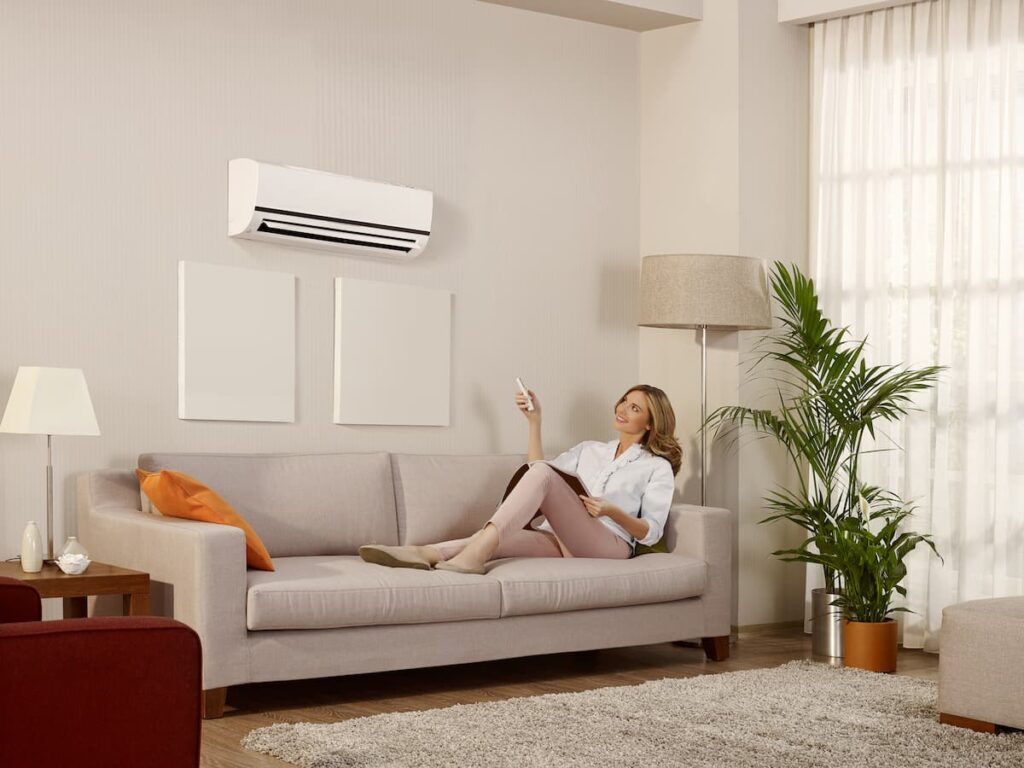


A ductless mini split heat pump system offers many benefits, including
(1) efficiency. Mini split heat pump systems offer superior efficiency to ducted central air system, which lose heating and cooling as air passes through long ducts. A well designed mini split heat pump system can be approximately 30% more efficient than a comparably sized ducted air conditioning system.
(2) heating and cooling. A mini split heat pump system balances temperature differences in inside and outside air, allowing it to provide cooling in hot summer months and heating on cold winter nights.
(3) cost-savings. Not only is a mini split heat pump system less costly to run than window AC units or ducted central air, it also generates savings in comparison to oil-based heating, making it a year-round cost saver.
(4) flexibility. In contrast to traditional heat or AC systems, which often rely on a central sensor to tell the entire system when to turn on or off, a mini split heat pump system allows you to select the zones of your house that will be climate controlled and to different temperatures for different zones at different times.
(5) rebate or tax-credit eligibility. Because of the greater efficiency provided by mini split heat pump systems, state and federal governments provide incentives in the form of tax credits and cash rebates to assist and encourage homeowners to install mini split systems. In some cases, most of the cost of installation may be covered!
(6) no ducts. Ducts are expensive to install, take up lots of space, and are difficult to maintain. It is unlikely that ducts will remain perfectly sealed, if they are ever properly sealed at all, which allows the conditioned air to escape. In turn, that means you system will worker harder than it should. The United States DOE has estimated that up to 30% of energy spent to run ducted ir conditioning systems comes from losses due to unsealed ducts.
(7) a sound investment. A well designed mini split heat pump system is becoming a feature that potential home buyers and renters value and expect, and as a result, installing and maintaining an appropriately sized mini split heat pump system can increase the value of your home and make it a more attractive option for future buyers or renters.
Mini split heat pumps, also called ductless heat pumps or mini splits, are comprised of (1) an outdoor compressor unit, and (2) an indoor air handling unit, sometimes called a “head.” These components are connected by refrigerant piping or cabling and electrical wiring.
The refrigerant operates to transfer heat from warmer to colder areas. Thus, in warm summer months, it moves heat from inside to the outside of the house, thereby cooling the house. In winter the process is reversed, as heat is moved from the outside in, thereby warming the house.
Generally, installation of a mini split heat pump system involves setting the outdoor condenser on a level pad, mounting the head or heads in the appropriate location(s) inside, and running conduit (containing the wiring and the cables) from the condenser to the head(s). The conduit typically requires a three-inch hole on the exterior at the entrance point.
The number of condensers and heads is a function of the size and layout of the home, and the homeowners’ desires in terms of climate control. A small house or condo may require just one condenser and one head, whereas a mini split heat pump system for a large home could require multiple condensers, each of which could be connected to multiple heads.
NE Mini Split Installers installs industry-leading mini split heat pump systems, including systems manufactured by Fujitsu and Mitsubishi. Our relationships with these and other manufacturers and our ability to sell, service, and install their products allows us to provide you with the best pricing at the best time on the most appropriate mini split heat pump system for your home.
The specific system that is best for you depends on factors such as the size, layout and number of rooms that you want climate-controlled, whether you have another heating system that will supplement the heat pump, the climate in your location, the design of the system and the number of heads and condensers you will require, and your budget. Our team will discuss these factors with you during their site visit, help you select the right mini split system, and incorporate it into your customized proposal.
Routine maintenance is necessary to ensure that you capture all the efficiency savings provided by a properly functioning mini split heat pump system. Standard maintenance includes changing the filters, checking coils and replacing them if necessary, cleaning the system and checking for any condensation, moisture or mildew. If you make or have made the substantial investment to install a mini split heat pump system, we strongly recommend that you maintain it properly.
The NE Mini Split Installers price for installation of a mini split heat pump system includes everything you need to operate your system properly. This includes the condenser, the pad and frame, head(s), all wiring and cabling, coolant, and testing to ensure system integrity and operation.
Yes. In addition to saving you money on energy bills, a well-designed and properly maintained mini split system can add to the value of your home. Many home builders are incorporating mini split heat pump systems into new construction and developments, and many home buyers view mini split heat pump systems as an asset when evaluating a prospective home.
Effective January 1, 2023, the federal Inflation Reduction Act provides homeowners with a tax credit of up to 30% of the installation cost of certain mini split heat pumps, up to a maximum of $2,000. In addition, the High Efficiency Electric Home Rebate Act also offers a point-of-sale rebate on heat pumps installed for heating and cooling that can be up to $8,000. These rebates are administered by the states, and so specific details and amounts vary by state. NE Mini Split Installers will work with you to help you take advantage of these tax credits and rebates.